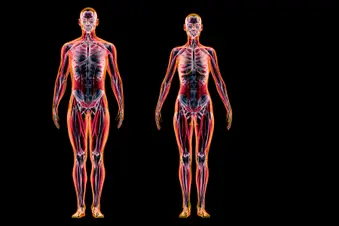
Type 2 diabetes is a chronic disease that stops your body from using insulin the right way. If you’ve been diagnosed with type 2 diabetes, it means your blood sugar (or glucose) levels are too high.
Insulin is a hormone made in the pancreas. It helps carry glucose to the body’s cells. Glucose comes from many of the foods we eat. Your body uses glucose as energy to feed your brain, muscles, and heart. If glucose can’t reach the cells, it builds up in the blood, and the cells stop working the way they’re supposed to. This is why type 2 diabetes can affect the whole body.
Symptoms of Type 2 Diabetes
Some people who have type 2 diabetes have mild symptoms they hardly even notice. Symptoms can also start showing up slowly and throughout several years.
But it’s a good idea to check with your doctor if you have any of the following symptoms:
- Feeling more thirsty and peeing more
- Feeling more hungry than usual
- Feeling tired
- Having blurred vision
- Feeling numbness or tingling in your hands or feet
- Having sores that heal slowly or don’t heal
- Losing weight without exercising or dieting
- Having infections often
- Having darkened areas of skin (usually on the neck and armpits)
The Effect of Type 2 Diabetes on the Rest of the Body
When blood sugar levels stay high for too long, it can cause major cardiovascular damage. It can lead to heart disease, vision loss, or kidney disease.
Many health professionals consider type 2 diabetes to be one of the risk factors for cardiovascular disease. In fact, people with type 2 diabetes are twice as likely to get cardiovascular disease as people who don’t have diabetes. Cardiovascular disease (heart attacks, strokes, and heart failure) is the leading cause of death in people with type 2 diabetes.
In addition to any diabetes medicines, a type 2 diabetes treatment plan should include exercise and a healthy diet so you can keep your body as healthy as possible.
Diabetes Complications
When you keep blood glucose levels under control, it’s possible to lower the risk of developing other diseases and complications.
Heart and other cardiovascular diseases. Diabetes is linked with a higher risk of heart disease, stroke, high blood pressure, and atherosclerosis (which causes narrowing of the blood vessels).
Nerve damage in the arms and legs. High blood glucose levels can damage or destroy nerves, causing neuropathy. This can cause tingling, numbness, burning, pain, or a loss of sensation in the tips of the toes or fingers, which begins to spread upward.
Nerve damage in various organs of the body. Damage to the nerves in the heart can cause irregular heart rhythms. Nerve damage related to the digestive system can cause problems such as nausea, vomiting, diarrhea, or constipation. It can also cause erectile dysfunction.
Kidney disease. Diabetes can lead to chronic or irreversible kidney disease. This may require dialysis or a kidney transplant.
Eye damage. Diabetes can lead to eye diseases, such as cataracts and glaucoma. It can also damage the blood vessels in the retina, which can lead to blindness.
Skin conditions. Diabetes can cause skin problems, such as bacterial and fungal infections.
Slow healing. If left untreated, cuts and blisters can lead to serious infections. Serious damage can lead to amputation.
Hearing impairment. Hearing problems are more common in people who have diabetes.
Sleep apnea. Obstructive sleep apnea is common in people with type 2 diabetes. Obesity can be the main cause of both conditions.
Dementia. Type 2 diabetes seems to boost the risk of Alzheimer’s disease and other disorders that cause dementia. Poor blood glucose control can lead to a faster decline in memory and other thinking skills.
Diabetes and Depression
Depression is common among people who have type 2 diabetes. According to research studies, people with type 2 diabetes who have symptoms of depression:
- Have higher mortality rates than people with type 2 diabetes who don’t have depression
- Are less likely to follow diet and exercise guidelines or to control their blood glucose levels
- Are more likely to have three or more risk factors for heart disease than people who only have type 2 diabetes
- Are a lot more likely to have cardiovascular and cerebrovascular complications
People who don’t stay physically active are more likely to have depression.
Consider these tips:
Start a healthy routine. Following a routine can help you plan what to eat and at what time. It can also help you find set time to rest, exercise, and take your medicine on time. Having a routine can also help calm any anxiety or stress you might have.
Set realistic goals. Make a plan that lets you meet your physical and mental health goals. Celebrate all the accomplishments you have, whether large or small.
Talk to someone about how you feel. It’s important to talk to a mental health professional or loved one about any worries you might have. This is especially true if you have type 2 diabetes as well as symptoms of depression. Make sure to take care of your mental well-being.
Show Sources
Photo Credit: LEONELLO CALVETTI/Science Source
SOURCES:
American Diabetes Association: “Addressing Stigma: Diabetes and Mental Health,” “Blood Glucose (Sugar) Can Make a Big Difference.”
CDC: “Type 2 Diabetes,” “Who Is at Risk?”
NIDDK: “Insulin Resistance and Prediabetes,” “Type 2 diabetes.”
Joslin Diabetes Center: “Can Type 2 Diabetes Be Reversed?”
Mayo Clinic: “Type 2 diabetes.”
MedlinePlus: “Type 2 Diabetes.”
News release, University of Washington.